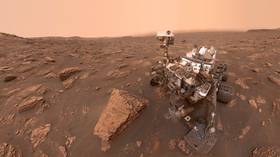NASA discovery boosts hope of life on Mars (VIDEO)

A snapshot from NASA’s Curiosity rover has revealed compelling evidence that a large body of water once existed in an area of the planet previously thought to have been a barren wasteland, the American space agency announced this week.
The rover, which has been exploring the planet for more than a decade, has vastly increased our understanding of the Martian landscape since it landed on the planet’s surface in 2012.
But a recent discovery at an area of the planet known as the ‘sulfate-bearing unit’ has NASA particularly excited, after they found the “clearest evidence yet” of signs that a significant lake likely existed in an area previously thought to have contained only small trickles of water.
“This is the best evidence of water and waves that we’ve seen in the entire mission,” said NASA’s Aswin Vasavada in a statement this week. “We climbed through thousands of feet of lake deposits and never saw evidence like this – and now we found it in a place we expected to be dry.”
A new panorama from @MarsCuriosity provides some of the clearest evidence yet that ancient waves once lapped Martian lakeshores—in a region that scientists didn't expect: https://t.co/kS4i8PWBgtpic.twitter.com/kzXtJRqLy6
— NASA (@NASA) February 9, 2023
It is hypothesized that if life – microbial or otherwise – ever existed on Mars, evidence of this could potentially be discovered near where water was once concentrated. Scientists also expect to find clues as to how the once watery planet transformed into the freezing wasteland it is today.
“Billions of years ago, waves on the surface of a shallow lake stirred up sediment at the lake bottom, over time creating rippled textures left in rock,” NASA added in its statement on Wednesday.
However, efforts to drill for samples at the foothills of Mount Sharp – a three-mile-high mountain which once contained streams and lakes – have been complicated by the rover encountering rocks too hard for its drill.
“Mars’ ancient climate had a wonderful complexity to it, much like Earth’s,” Vasavada added.
The discovery of water on Mars was first confirmed by NASA’s Phoenix Mars lander in 2008, with subsequent missions locating a large subglacial lake one mile below the southern polar ice cap in 2018.












